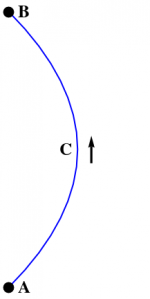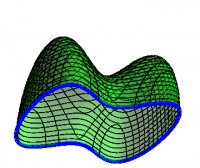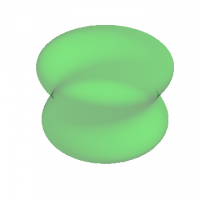- §1. Vectors and Forms
- §2. Line & Surface Integrals
- §3. Integrands Revisited
- §4. Stokes' Theorem
- §5. Calculus Theorems
- §6. Integration by Parts
- §7. Further Corollaries
Calculus Theorems
We restate the results in the previous section, reversing the order. Stokes' Theorem for differential forms says that \begin{equation} \int_R d\alpha = \int_{\partial R} \alpha \end{equation} for any $p$-form $\alpha$ and any ($p+1$)-dimensional region $R$. All of the standard theorems in calculus relating integrals over regions and their boundaries are special cases of Stokes' Theorem.
Fundamental Theorem of Calculus
The Fundamental Theorem of Calculus is about integrating the derivative of a function along a curve, namely: \begin{equation} \int_C df = \int_{\partial C} f = f\Big|_A^B \end{equation} where the curve $C$ starts at point $A$ and ends at point $B$, as shown in Figure 1. This theorem includes both the single-variable statement that \begin{equation} \int_a^b \frac{df}{dx} \>dx = f(b)-f(a) \end{equation} in which case the curve lies along the $x$-axis, but also the Fundamental Theorem for Gradient, namely \begin{equation} \int_C \grad f\cdot d\rr = f\Big|_A^B \end{equation} along any smooth curve $C$.
Green's Theorem
Green's Theorem is about integrating vector fields in the plane. If $F=F_x\,dx+F_y\,dy$, then \begin{equation} dF = \left( \Partial{F_y}{x} - \Partial{F_x}{y} \right) \> dx\wedge dy \end{equation} so that \begin{equation} \int_S dF = \int_{\partial S}F \Longrightarrow \int_S \left( \Partial{F_y}{x} - \Partial{F_x}{y} \right) \> dA = \oint_{\partial S} F_x\,dx+F_y\,dy \end{equation} which is the special case of Stokes' Theorem restricted to the plane.
Stokes' Theorem
Stokes' Theorem is about integrating the curl of a vector field. If $F=\FF\cdot d\rr$, then \begin{equation} dF = *({*}dF) = \grad\times\FF\cdot d\AA \end{equation} so that \begin{equation} \int_S dF = \int_{\partial S}F \Longrightarrow \int_S \grad\times\FF\cdot d\AA = \oint_{\partial S} \FF\cdot d\rr \end{equation} The surface $S$ and its boundary $\partial S$ are shown in Figure 2.
Divergence Theorem
The Divergence Theorem is about integrating the divergence of a vector field. If $F=\FF\cdot d\rr$, then \begin{align} {*}F &= \FF\cdot d\AA \\ d{*}F &= *({*}d{*}F) = \grad\cdot\FF \>dV \\ \end{align} so that \begin{equation} \int_R d{*}F = \int_{\partial R}{*}F \Longrightarrow \int_R \grad\cdot\FF \>dV = \oint_{\partial R} \FF\cdot d\AA \end{equation} The region $R$ and its boundary $\partial R$ are shown in Figure 3.


